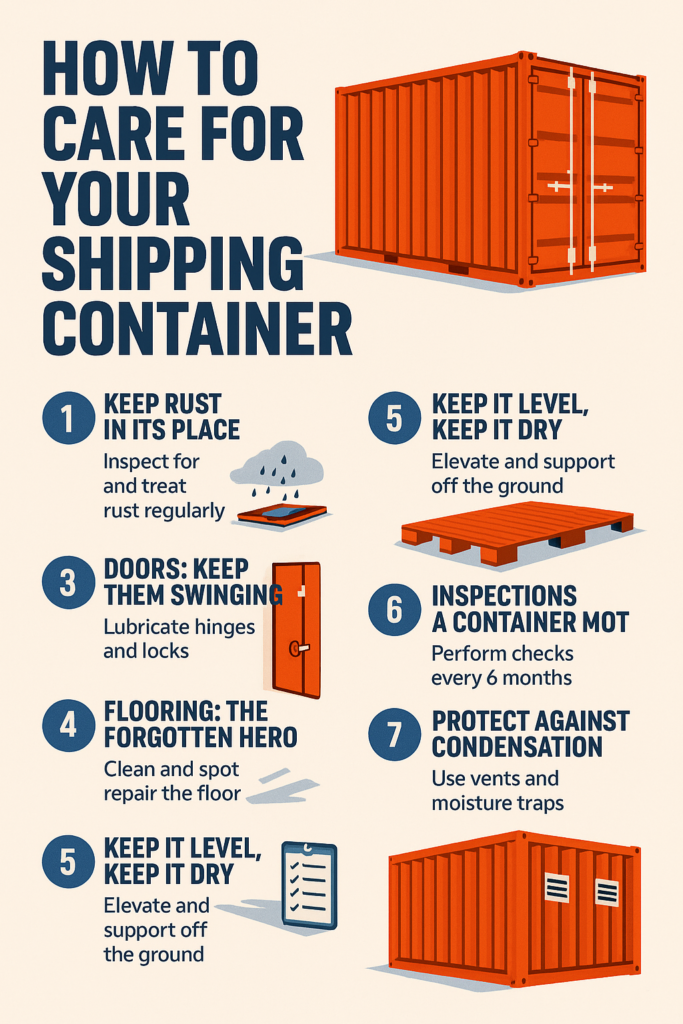Ever wondered if your shipping container is indestructible steel armour, or if it actually needs a bit of TLC to survive British weather?
Shipping container maintenance: Shipping containers are built like tanks. They travel across oceans, get battered by storms, stacked six high on ships, and still keep your stuff bone-dry. But once they retire from the high seas and land in your yard, garden, or building site, they’re not completely maintenance-free.
Ignore a container for a few years and it’ll remind you of your neglect: rusty patches, stiff doors, dodgy floors, and leaks in places you didn’t know existed. With prices for a 20ft container hovering between £1,800–£3,000 (depending on grade), extending its life isn’t just smart—it’s economical.
The good news? A little regular care can add decades to a container’s usable lifespan. And no, we’re not talking about expensive refurbishments every year. Just simple, practical checks that keep rust at bay, doors swinging, and contents secure.
Let’s walk through the ultimate care guide for your container, with a dash of humour (because nobody likes reading “clean your gutters” without a joke attached).
1. Keep Rust in Its Place
Steel hates moisture, and the UK is basically one giant drizzle machine. Even Corten steel (the rust-resistant alloy used in containers) eventually gives in if ignored.
Maintenance tips:
- Inspect your container at least twice a year—look for bubbling paint, orange patches, or surface scratches.
- Sand down rust spots, prime, and repaint with marine-grade paint. (Think of it as a spa treatment for your box.)
- Don’t let puddles sit on the roof—it accelerates corrosion.
Pro tip: Keep a small tin of touch-up paint handy. Treat rust early, and you won’t end up with a giant hole in your wall.
2. Check the Roof—Your Container’s Umbrella
The roof takes the brunt of rain, snow, and whatever pigeons feel like dropping. Unlike the sides, roofs aren’t designed to hold weight, so avoid stacking junk, bricks, or Aunt Mabel’s caravan parts up there.
Maintenance tips:
- Clear leaves, debris, and standing water.
- Never park it under dripping gutters or overhanging trees—constant moisture = rust party.
- If you see dents, repair them quickly—dents hold water, and water equals rust.
3. Doors: Keep Them Swinging, Not Sticking
Container doors are notorious for becoming stiff. It’s not because they’re “badly made”—it’s because dust, dirt, and rust build up on hinges and locking rods.
Maintenance tips:
- Lubricate hinges, locking bars, and seals with grease or WD-40 every few months.
- Check the rubber seals—if they’re cracked or brittle, replace them.
- Make sure the container is level. If it sits unevenly on the ground, the frame twists slightly and the doors won’t close properly.
Think of doors as knees. They only work if you keep them moving.
4. Flooring: The Forgotten Hero
Most containers have marine plywood floors, tough but not indestructible. Over time, heavy loads, spills, and damp can weaken them.
Maintenance tips:
- Sweep regularly—grit grinds into the wood.
- Treat spills immediately. Oil and chemicals can soak in, weakening the wood.
- Raise goods off the floor with pallets to improve airflow and reduce damp.
- If planks are damaged, replace them before rot spreads.
5. Keep It Level, Keep It Dry
Containers like to sit on flat, dry ground. Plonking them straight onto grass or mud is a recipe for rust.
Maintenance tips:
- Use concrete pads, paving slabs, or railway sleepers under the corners.
- Make sure there’s airflow beneath to stop moisture collecting.
- Avoid placing directly on soft ground—it’ll sink, twist, and cause door issues.
6. Inspections: A Container MOT
You wouldn’t drive your car for ten years without a service (well, some would, but you shouldn’t). Same with containers.
Maintenance checklist (do every 6 months):
- Check for dents, rust, and bubbling paint.
- Inspect doors and locks.
- Check seals are intact.
- Look inside on a sunny day—light leaking in means water can too.
- Sweep floors and check for soft spots.
7. Protect Against Condensation
In the UK, condensation is inevitable—warm day, cold night, and suddenly your storage unit feels like a greenhouse.
Maintenance tips:
- Use moisture traps or dehumidifiers if storing sensitive items.
- Install vents for airflow.
- Consider anti-condensation roof coating if using for long-term storage.

Case Study: The Farmer Who Beat the Rust
Tom, a farmer in Yorkshire, bought a Grade B 40ft container in 2015 for £2,900 to store tools and animal feed. For the first year, he ignored it completely. By year two, rust patches had spread along the roof, and the doors needed a crowbar to open.
In 2017, after nearly losing half his feed to damp, he started a basic care routine:
- Painted over roof rust once a year.
- Greased the doors every six months.
- Put concrete blocks under the corners to improve drainage.
Fast forward to 2025—10 years on. His container is still watertight, still in daily use, and worth at least £1,800 if sold. Without care, it would’ve been scrap years ago. Instead, it’s given him a decade of reliable service for just a couple of hours of maintenance a year.
“Treat your container like a classic car. Ignore it, and it’ll rot. Care for it, and it’ll outlive you.”
Want a container that lasts decades, not years? At Cubus Containers, we supply quality units and give you the know-how to keep them fighting fit. Contact us today to find your next long-lasting container.
How Containers Are Graded (A, B, C): What It Means for You










